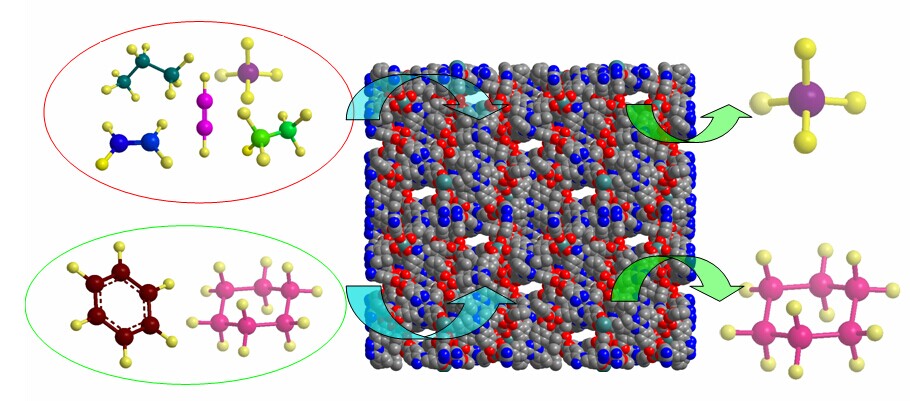
Researchers Develop Porous Anionic Indium–Organic Framework with Enhanced Gas and Vapor Adsorption and Separation Ability
Aug 05, 2014 Email"> PrintText Size

Because of the similar sizes and volatilities of the light hydrocarbons, separation of these gas mixtures must be performed at low temperatures and high pressures when using traditional cryogenic distillation, causing large energy costs for the chemical industry. Selective adsorption separation of light hydrocarbons is one of the most promising alternative energy- and cost-efficient methods.
Recently, Metal–organic frameworks (MOFs) have been receiving intensive research interest because of their high specific surface area and potential applications in gas storage, separation, and catalysis. However, up to now, most of the MOFs applied to the CO2, H2, CH4 adsorption separation are neutral materials. Little research uses organic cations in MOFs and its effect on the light hydrocarbons and vapors adsorption separation.
The research group led by Prof. CAO Rong at Fujian Institute of Research on the Structure of Matter, Chinese Academy of Sciences, has prepared a new anionic microporous MOF material with large unit cell volume using solvothermal approach in the presence of tetraethylammonium chloride as template.
The material y shows high adsorption uptakes of C2 and C3 hydrocarbons, but also exhibits highly selective separation of propane, acetylene, ethane, and ethylene from methane at room temperature. The high adsorption capacities for light hydrocarbons can be ascribed to the stronger interactions of those gas molecules with the anionic framework and the ethyl groups of the cationic Et4N+ in the pores, which provides dispersion-force interactions with light hydrocarbons. In addition, it exhibits highly efficient adsorption separation of polar molecules from nonpolar molecules.
The study provides experimental basis for the charged MOFs for the application of adsorption and separation gases. Results of this study have been published as an article in ChemSusChem, 2014. DOI: 10.1002/cssc.201402206.

Porous anionic indium–organic framework for the gas and vapor adsorption and separation (Image by Prof. CAO's group)
Because of the similar sizes and volatilities of the light hydrocarbons, separation of these gas mixtures must be performed at low temperatures and high pressures when using traditional cryogenic distillation, causing large energy costs for the chemical industry. Selective adsorption separation of light hydrocarbons is one of the most promising alternative energy- and cost-efficient methods.
Recently, Metal–organic frameworks (MOFs) have been receiving intensive research interest because of their high specific surface area and potential applications in gas storage, separation, and catalysis. However, up to now, most of the MOFs applied to the CO2, H2, CH4 adsorption separation are neutral materials. Little research uses organic cations in MOFs and its effect on the light hydrocarbons and vapors adsorption separation.
The research group led by Prof. CAO Rong at Fujian Institute of Research on the Structure of Matter, Chinese Academy of Sciences, has prepared a new anionic microporous MOF material with large unit cell volume using solvothermal approach in the presence of tetraethylammonium chloride as template.
The material y shows high adsorption uptakes of C2 and C3 hydrocarbons, but also exhibits highly selective separation of propane, acetylene, ethane, and ethylene from methane at room temperature. The high adsorption capacities for light hydrocarbons can be ascribed to the stronger interactions of those gas molecules with the anionic framework and the ethyl groups of the cationic Et4N+ in the pores, which provides dispersion-force interactions with light hydrocarbons. In addition, it exhibits highly efficient adsorption separation of polar molecules from nonpolar molecules.
The study provides experimental basis for the charged MOFs for the application of adsorption and separation gases. Results of this study have been published as an article in ChemSusChem, 2014. DOI: 10.1002/cssc.201402206.

Porous anionic indium–organic framework for the gas and vapor adsorption and separation (Image by Prof. CAO's group)
CAS Institutes
There are 124 Institutions directly under the CAS by the end of 2012, with 104 research institutes, five universities & supporting organizations, 12 management organizations that consist of the headquarters and branches, and three other units. Moreover, there are 25 legal entities affiliated and 22 CAS invested holding enterprisesThere are 124 I...>> more
Contact Us

Chinese Academy of Sciences
Add: 52 Sanlihe Rd., Xicheng District, Beijing, China
Postcode: 100864
Tel: 86-10-68597592 (day) 86-10-68597289 (night)
Fax: 86-10-68511095 (day) 86-10-68512458 (night)
E-mail: cas_en@cas.cn

